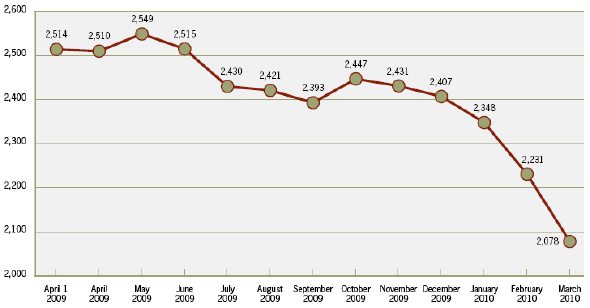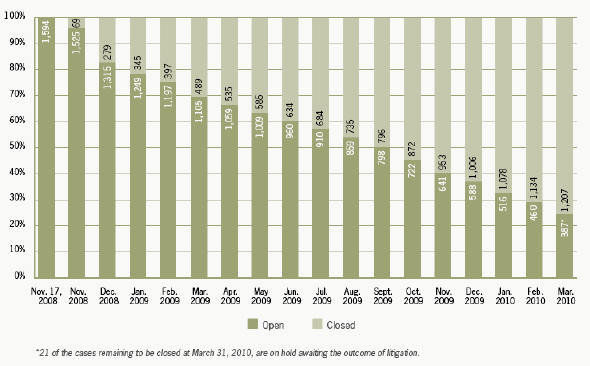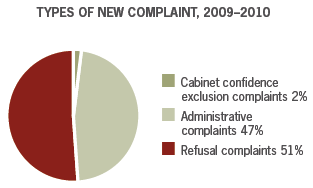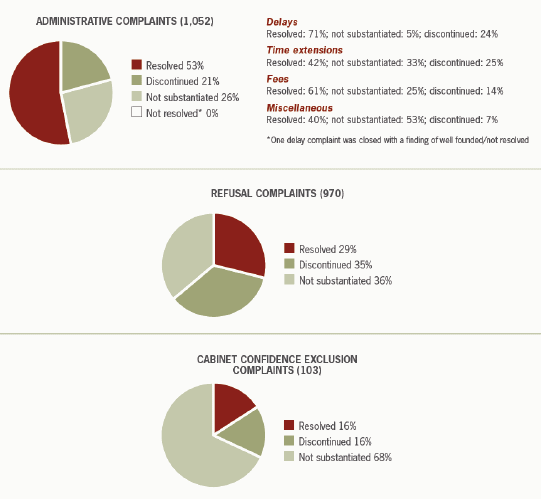2009-2010 1. Taking critical action on investigations
Having already built a firm organizational foundation, we focused our energy, time and attention this year on our investigative function. We fully staffed our teams. We took significant corrective action to meet our targets for completing both recent and longstanding cases. Our success is evident in the decreasing size of our caseload and our more timely service to Canadians. And we have clear goals for continuing improvement.
This was a year of noteworthy achievements for the Office of the Information Commissioner in the area of investigations. We closed more complaints than we have in any year in the past two decades, and we made the largest dent ever in our caseload. The number of cases we have had on file for more than two years continued to fall. We also reduced by nearly one third the average time it took us to conclude investigations into our more recent complaints.
These successes were the direct results of our concerted effort to significantly improve our investigative function, based on detailed assessment of our caseload and the effectiveness of the processes we had introduced last year as part of our new business model.
With more useful and accurate statistics and analysis in hand than ever before—the fruits of our plan to enhance our statistical reporting—we clearly saw that we needed to take focused measures to maximize our efficiency gains (see “Keys to our success,” below for details). Our first priority was to hire and train new staff to bring our workforce up to full strength. We also honed our approach to managing cases and made crucial adjustments to our processes.
Keys to our success
In September 2009, we drew up a comprehensive action plan to maximize our efficiency gains and provide more timely and effective response to complaints.*
Building our capacity
- We implemented an integrated human resources strategy.
- We staffed our investigative teams to full capacity.
- We hired experienced investigators on contract to work on our oldest and most complex cases.
- We developed an in-house program of targeted training.
- We placed renewed emphasis on our career development program.
- We developed, monitored and adjusted targets for investigators.
Enhancing case management
- We adopted a portfolio approach to investigations.
- We collaborated with complainants and institutions to resolve complaints and sought feedback on how best we could assist them.
- We dedicated a team to our longstanding cases.
- We closely monitored our progress on files and promptly raised issues of concern with senior institutional officials, when required.
Auditing and adjusting our processes
- We improved our intake processes.
- We simplified how we prioritize complaints.
- We streamlined our approach to the early resolution of straightforward complaints.
- We published practice directions that set out clear guidelines on aspects of our processes.
By the numbers
We closed 2,125 complaints this year (see Table 1). This is a 20 percent increase in completed cases from 2008–2009. With the exception of 1989–1990 (when we closed 3,011 files, three quarters of which were against one institution), this is the highest number of cases we have closed in our 27-year history.
Table 1. Summary of caseload, 2008-2009 and 2009-2010
| Requester-initiated complaints | Commissioner-initiated complaints | Total | ||||
| 2008-2009 | 2009-2010 | 2008-2009 | 2009-2010 | 2008-2009 | 2009-2010 | |
| Complaints carried over from the previous year | 2,293 | 2,513 | 0 | 1 | 2,293 | 2,514 |
| New complaints | 2,018 | 1,653 | 1 | 36 | 2,019 | 1,689 |
| Complaints cancelled* | 28 | n/a | 0 | n/a | 28 | n/a |
| Total complaints to investigate | 4,283 | 4,166 | 1 | 37 | 4,284 | 4,203 |
| Complaints completed with findings | 1,118 | 1,516 | 0 | 34 | 1,118 | 1,550 |
| Complaints discontinued | 652 | 575 | 0 | 0 | 652 | 575 |
| Total complaints closed | 1,770 | 2,091 | 0 | 34 | 1,770 | 2,125 |
| Complaints pending at year-end | 2,513 | 2,075** | 1 | 3 | 2,514 | 2,078 |
| Report cards completed | 10 | 24 |
*We stopped using this category in June 2008; these 28 complaints were cancelled before that change was made.
**127 of these complaints are on hold awaiting the outcome of litigation.
We had 1,689 new complaints this year, including 36 that the Interim Commissioner initiated herself. Overall, this equals 330 fewer complaints than last year. This is the second year in a row that the number of new complaints has dropped since the spike in 2007-2008, which saw us receive 2,387 complaints. This jump was largely due to the 536 complaints we received about the Canadian Broadcasting Corporation.
The number of cases we had open decreased nearly every month (see Figure 1), continuing the downward trend that began in the summer of 2008. Overall for the year, our caseload decreased 17 percent (436 files), which is the largest drop in our history.
Figure 1. Number of open complaints, 2009-2010

The drop in caseload includes a steady decrease in the number of longstanding complaints (dating from before April 1, 2008). As Figure 2 shows, we started the year with 1,105 of these files. By year-end, that number had shrunk to 387, a decrease of 65 percent. Overall, since mid-November 2008, we have closed 76 percent of these cases.
Figure 2. Status of longstanding complaints, November 2008 to March 2010

Finally, we reduced the overall average time it took to conclude investigations on our more recent complaints (those dating from after April 1, 2008) from 343 days in 2008-2009 to 245 in 2009-2010 (a 29 percent decrease). We also concluded more investigations more quickly than the year before. For example, the number of complaints we closed in fewer than three months grew by 68 percent, while the number we concluded in three to six months increased by 44 percent (see Figure 3).
Continuing improvement
In 2009-2010, we closed 21 percent of our most straightforward complaints within three months. With continuing improvement to the front end of our investigation process, our goal is to complete 85 percent of these complaints within that timeframe next year. To do so, we will solicit the cooperation of institutions, in particular Foreign Affairs and International Trade Canada, National Defence, Privy Council Office, the Canadian Broadcasting Corporation and Parks Canada. These institutions were responsible for 73 percent of the straightforward complaints that took longer than three months to wrap up this year.
Figure 3. Turnaround time for complaints closed, 2008-2009 and 2009-2010
![[image]](/sites/default/files/userfiles/images/oic-eng/annual_report/2009-2010/figure-3-eng.gif)
Note: While the total number of complaints closed in 2009-2010 shown in Figure 3 (2,125: the sum of the figures above each bar) equals the total in Table 2, below, for 2009-2010, the categories in the figure and the table do not align. For example, a complaint that was registered in December 2007 and closed in April 2009 would appear in the “2007-2008” category in Table 2, but in the “One to two years” category in Figure 3, since it took 16 months to complete.
The average time it took to complete all complaints jumped from 401 days in 2008-2009 to 450 days in 2009-2010. The age of some of our longstanding complaints contributed to this increase. Since we are still carrying more than 100 cases that date from prior to 2007-2008 (see Table 2), our average turnaround time will continue to grow until we fully achieve the efficiencies possible with our process improvements. These include closing all the longstanding complaints and carrying over only 300 to 500 cases each year. We are committed to continuing to improve our methods and take other necessary measures to clear these older cases as soon as possible.
Table 2. Age of complaints closed in 2009-2010 and the number that remain to be closed
| Year we registered the complaint | Number we closed in 2009-2010 | How many we have left to close |
| 2002-2003 | 1 | 1 |
| 2003-2004 | 4 | 3 |
| 2004-2005 | 17 | 10 |
| 2005-2006 | 33 | 23 |
| 2006-2007 | 151 | 66 |
| 2007-2008 | 512 | 284 |
| 2008-2009 | 796 | 613 |
| 2009-2010 | 611 | 1,078 |
| Total | 2,125 | 2,078 |
Keys to our success
Building our capacity
A crucial prerequisite for success was having enough qualified employees to handle our caseload. Under our integrated human resources plan, we had already begun to recruit and train new investigators. However, it became apparent this year that even with that increased capacity we were not going to meet our targets. Consequently, we directed more resources to our investigative teams, particularly the group working on our longstanding cases. Overall, we hired 20 new people to work in the investigations area, and brought in 10 experienced investigators on contract to help complete our most complex cases. (See Figure 4.)
Figure 4: Resources, 2009-2010
![[image]](/sites/default/files/userfiles/images/oic-eng/annual_report/2009-2010/figure-4-eng.gif)
Beyond securing more investigative staff, we focused on providing our investigators with the support they needed to perform effectively. We placed experienced leaders at the head of each investigation team to mentor our many new employees. We introduced an in-house continuous learning program. In particular, we provided targeted training to help investigators stay current with developments in the field of access to information, recent court proceedings and best practices in carrying out investigations. These efforts to develop the skills and expertise of our workforce will help us retain staff, maintain our productivity and provide quality services.
Continuing improvement
We will continue to add to our in-house learning program for investigators. In particular, we will be enhancing the legal component of this training to ensure investigators are aware of the latest jurisprudence related to the Access to Information Act and how to work with some of the complex exemptions and exclusions in the legislation.
We are also looking to the future to plan for changes in workload and circumstances by creating pools of qualified investigators to draw from when needed. We also placed renewed emphasis on our career development program for investigative staff to facilitate internal promotion. We also examined how to create mobility within the organization among existing resources. Moreover, we discussed with the Canada School of Public Service how to address the chronic shortage of qualified staff in the access to information field across government, in the context of public service renewal.
We introduced and clearly communicated targets for each of our investigation teams and for individual investigators. We ensured teams and individuals were meeting their assigned targets through weekly monitoring of both achievements and obstacles. This helped motivate our workforce, as we strove each month to wind up as many investigations as possible.
All employees received monthly statistical reports on our caseload. This facilitated collaboration and mutual support across the organization and, consequently, aided our efficiency. We also improved these reports to allow us to better forecast when and how to apply our investigative resources.
Enhancing how we manage our cases
We separated our caseload into recent and longstanding complaints and analyzed it accordingly to determine the best way to handle the various types of complaints we receive. Among other things, this allowed us to implement a portfolio approach to investigations. Our investigators now specialize in terms of types and topics of complaint, particular complainants and specific institutions. Using this approach, our investigators build working relationships with stakeholders, become well versed in the subject matter that complaints frequently address, and develop a better understanding of the specific circumstances leading up to complaints. This expertise contributes to our efficiency and helps us formulate better ways to respond to complaints and maximize compliance.
We stepped up our efforts to collaborate with institutions and encourage their cooperation during investigations. For example, we met with several deputy ministers and senior access officials during the report card process to better understand institutions’ working environment and mandate, and to determine how best to collaborate to resolve complaints. We also discussed the number and type of administrative complaints they receive. Through these conversations, it became apparent that these complaints—about delays, fees and other administrative matters—are a drain on both our resources and theirs. (They account for nearly half our caseload each year.) These meetings were a first step in working with institutions to significantly reduce the number of administrative complaints in the coming years. In fact, by understanding these complaints and the situations from which they arise, we can shed light on practices that can be improved in all institutions. We can also identify systemic problems that would benefit from broad-based solutions, involving central agencies and lawmakers.
Continuing improvement
We have begun a project to replace our case management software. This is a key tool our investigators use as they pursue their enquiries. A modern and efficient system will put more and better information at investigators’ fingertips and allow them to manage their time and monitor the progress of their files.
We took a strategic approach to closing longstanding cases. We dedicated a team to completing these files. We fully staffed the team with experienced investigators to handle the remaining cases, which are complex, and gave them each a diverse selection of files to work on to keep their interest. We worked with complainants to prioritize their longstanding complaints. This allowed us to discontinue some files and complete those of most importance to complainants. We also collaborated with institutions that were the subject of these complaints to develop strategies for dealing with groups of files and to identify priorities.
Auditing and adjusting our processes
Of critical importance to our success was the audit we commissioned in the winter of 2009 of our Intake and Early Resolution Unit. This unit carries out key tasks at the front end of our investigative process. The audit shed light on the performance of the unit while it was still a pilot project, giving us a chance to immediately adjust our approach.
- We created a dedicated group to handle all incoming correspondence when it became apparent that this task was diverting Intake group staff from their investigation-related responsibilities.
- By clarifying the duties of the members of the Intake group, we reduced by half the number of times a file has to change hands during the intake process.
- We issued a practice direction that confirms the 60-day deadline requesters have to file complaints, and sets out institutions’ responsibilities for informing requesters of that timeframe. This has reduced the number of complaints we find to be invalid because they were filed late. The practice direction is available on our website.
- We redesigned the complaint form to make it easier for complainants to send us, from the outset, all the information we need to validate complaints. This will help decrease the time it takes us to complete this step of the intake process. We posted the new form on our website.
- We eliminated the point-rating system we used during our complaint triage process, since it proved to be too complex and cumbersome. We issued a practice direction that sets out the new approach; it is available on our website.
Continuing improvement
Through more process improvements and other strategies, we plan to continue to reduce our caseload next year and close our oldest files. Ultimately, our goal is to have a manageable carry over of 300 to 500 cases each year by 2014-2015.
Our most significant time savings came from reducing how long it took to receive from institutions the records we need to carry out our investigations and to prepare files for investigators. This step now takes 42 days on average instead of 90. To achieve this, we developed and published on our website a practice direction containing clear expectations that institutions must submit the records to us within 10 days of our request. Since then, there has been considerable improvement in the turnaround from institutions, although we expect even faster responses in the future.
We also committed to taking immediate action when we encounter delay in receiving requested records. We have made it clear that we will not hesitate to use our formal powers under the Access to Information Act to collect records from an institution’s premises, or to issue an order compelling the institution to produce the records. We have also begun meeting with access staff and senior officials of institutions about which we receive a large number of complaints to explain our investigation process and emphasize the importance of receiving records quickly.
Looking ahead
Continuity in both action and purpose characterizes our priorities for 2010-2011. We will continue to monitor and adjust our investigation process to reap further benefits in efficiency and timeliness—particularly in light of the tight fiscal situation in our organization and across the government. In particular, we will monitor and evaluate the overall success of improvements related to staffing, timelines, productivity, monitoring and reporting. We will conduct performance assessments and reviews through internal audits.
In consultation with institutions and complainants, we will assess the effectiveness of our new online complaint form and our new intake procedures.
Continuing improvement
We intend to publish new practice directions on various topics related to our investigation process and other aspects of how we deal with complaints. These will clearly communicate our expectations to complainants and institutions and also provide insight into how we do our work.
As our enhanced investigation process gains in experience and maturity, we will turn our attention to developing new strategies to deal with our most challenging cases, building on our in-depth knowledge of our caseload. We will also be in a good position to determine where next we need to focus our investigative and training efforts.
Facts and figures
New complaints in 2009-2010, by institution
| Institution | Number of complaints |
| 1. Canada Revenue Agency | 261 |
| 2. Foreign Affairs and International Trade Canada | 136 |
| 3. Canadian Broadcasting Corporation | 134 |
| 4. Transport Canada | 112 |
| 5. National Defence | 100 |
| 6. Privy Council Office | 84 |
| 7. Citizenship and Immigration Canada | 72 |
| 8. Royal Canadian Mounted Police | 68 |
| 9. Correctional Service of Canada | 53 |
| 10. Canada Border Services Agency | 43 |
| 11. Industry Canada | 43 |
| 12. Public Works and Government Services Canada | 43 |
| 13. Canadian Air Transport Security Authority | 41 |
| 14. Health Canada | 37 |
| 15. Canada Post Corporation | 35 |
| Other (66 institutions) | 427 |
| Total | 1,689 |
Of the nearly 1,700 complaints we received in 2009-2010, 75 percent were against 15 institutions. (More than 250 are subject to the Access to Information Act.) Eleven institutions, including the first nine above, have been among the top 15 for at least the last three years.
Outcome of complaints completed with findings in 2009-2010, by institution
| Overall | With merit | Not substantiated | |
| National Defence | 159 | 97 | 62 |
| Canadian Broadcasting Corporation | 158 | 126 | 32 |
| Royal Canadian Mounted Police | 127 | 50 | 77 |
| Privy Council Office | 115 | 47 | 68 |
| Foreign Affairs and International Trade Canada | 94 | 68 | 26 |
| Transport Canada | 92 | 41 | 51 |
| Canada Revenue Agency | 68 | 58 | 10 |
| Citizenship and Immigration Canada | 61 | 20 | 41 |
| Public Works and Government Services Canada | 45 | 20 | 25 |
| Fisheries and Oceans Canada | 45 | 18 | 27 |
| Correctional Service of Canada | 44 | 28 | 16 |
| Canada Border Services Agency | 43 | 25 | 18 |
| Health Canada | 42 | 37 | 5 |
| Canada Post Corporation | 37 | 21 | 16 |
| Department of Justice Canada | 34 | 9 | 25 |
| Other (66 institutions) | 386 | 193 | 193 |
| Total | 1,550 | 858 | 692 |
Overall, we found 55 percent of the complaints we completed in 2009-2010 to have merit and 45 percent to be not substantiated. This split is generally true each year. In contrast, the record for each institution varies. This reflects a variety of factors, such as the characteristics of each complaint, along with the proportions of administrative complaints and refusal complaints.
Types of new complaint, 2009-2010

Our caseload was nearly evenly divided between administrative and refusal complaints. The administrative category has recently gotten to be a smaller proportion of new complaints, decreasing from 58 percent in 2007-2008 to 47 percent this year.
Delay complaints and complaints about the time extensions institutions take to process requests account for more than three quarters of the administrative complaints. These complaints are of particular concern to us, since they represent instances of institutions essentially denying information to requesters by not responding to requests on time or by improperly applying the rules set out in the Act. (See also, Chapter 4 and our special report, Out of Time, both of which focus on these types of complaint.)
Outcome of complaints closed in 2009-2010, by type

We found a larger proportion of administrative complaints than any other type of complaint to have merit in 2009-2010. Within the administrative category, we resolved 71 percent of delay complaints and 42 percent of time extension complaints.